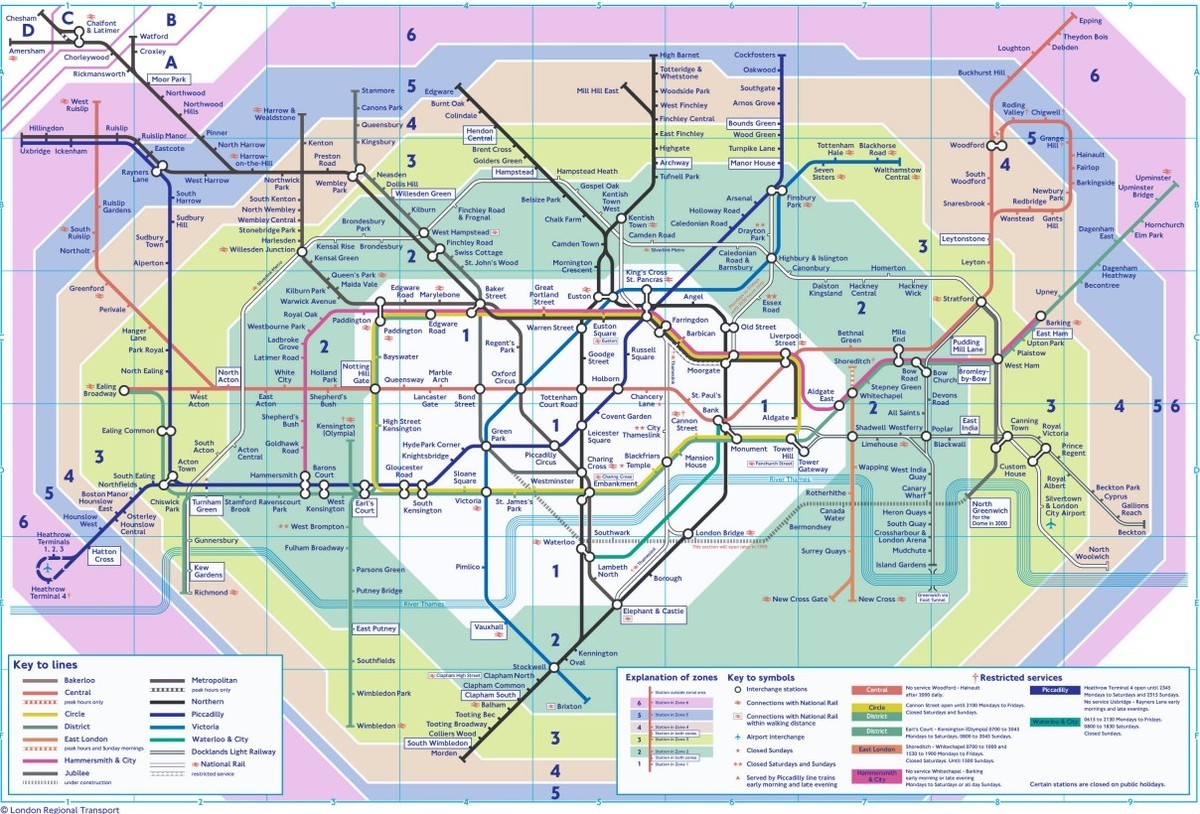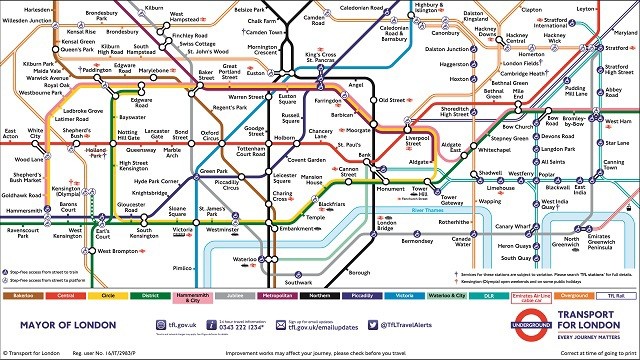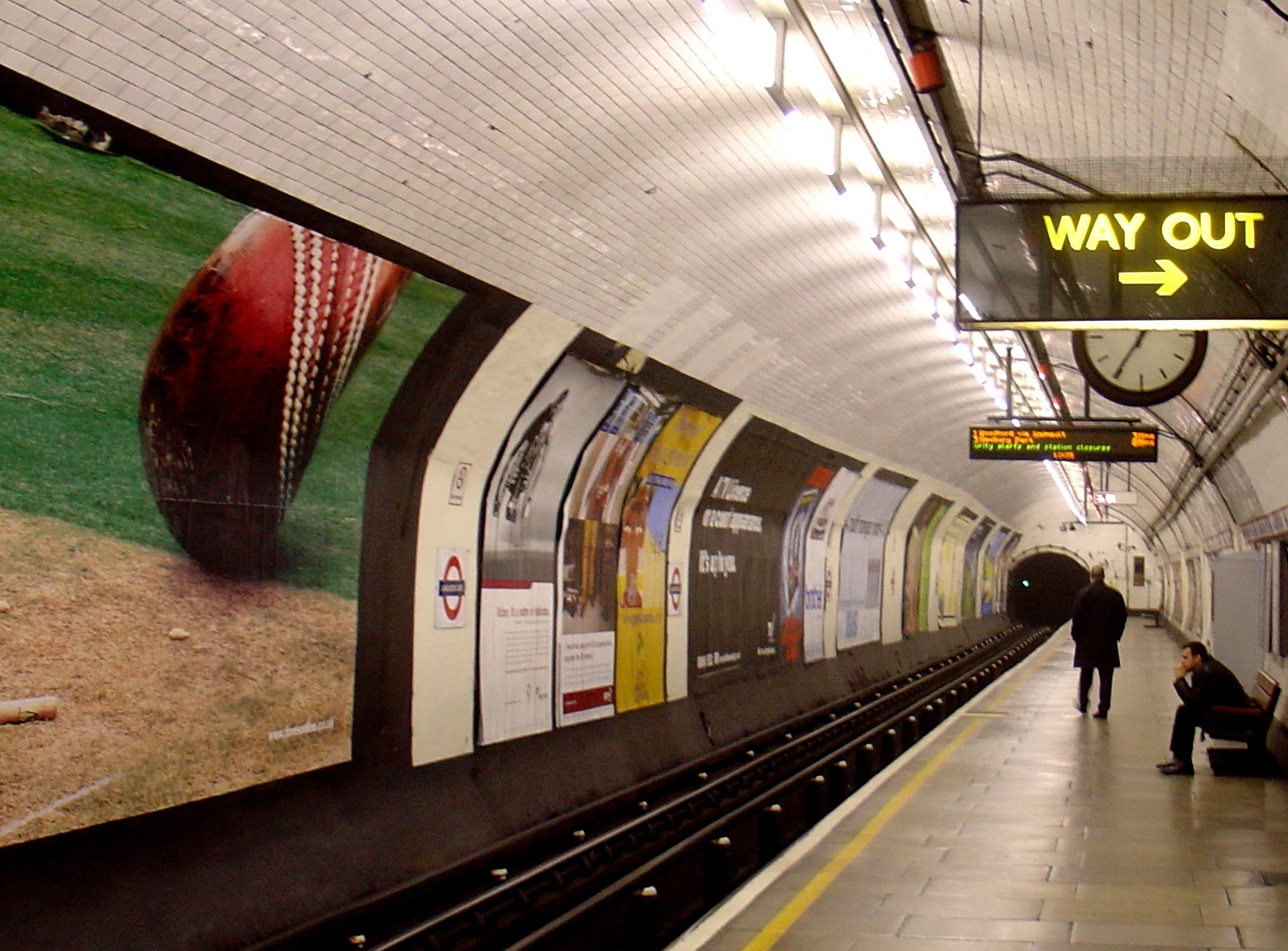London's underground part 1
London's underground - introduction

In this post I will tell you more or less how tube works in London, in my opinion you can get crazy, I wasn't patient enough, especially at the beginning.
I prepared several posts about it. Besides, I would like you to know how to reduce travelling costs. Let's be honest, London's transportation is very expensive. I think I didn't pay anywhere more for transportation than in London! It is important, especially when you're coming to London just for few days! You will read [in this chapter] about:
- History of London's underground;
- Underground's zones;
- Ticket's types;
- Ticket's prices;
- Underground's ethics;
- Other information;
Getting to London takes me about 2. 5 hrs from Bristol. Usually I am getting there by cheap coach-lines likeNationa Express or MegaBus. Happens that I can buy tickets TO London cheaper than actually tube tickets.
Usually I'm in London, because I am travelling from London's airports or I'm sightseeing or visiting my friends, but the common sense is that I have to use public transportation. First time I did it I thought I'm gonna explode.... Although this metaphor can be really dangerous nowadays.
I'd like to tell you what I learnt, what can help you, things you need to avoid etc. But in this post I will focus on the underground system because probably you'll be using it the most. Why? Because it's the easiest way to skip the traffic.
I usually use tube as well but happens that I travel by bus etc.
London's underground
First of all, you need to know that London is THE ZONE city what means that the transportation is between city zones.
It won't be a big surprise when I say that London being huge metropolis has really developed public transportation system, not only underground though.
There are several tube's lines, most of them crosses city center in some point. Interesting fact is that there are almost 300 underground's stops! I'd like to tell you that when you get in it might seem like you're in regular train crossing bridges and being "on the ground", so don't worry. I know "UNDERground" but around half of the tube's connection takes place "ON" the ground.
Zones
Why is it important to orientate in zones? I will interest you less when you're there for a couple of days, but if you're planning ongoing there to study or for the internship, this info might be really useful.

Finding the flat's localization"
Londoners use underground station to define flat's localization. That is actually really useful because it saves you time on looking the place yourself.
Tourists attractions
It's almost the same with tourists attractions, they're describe by underground's station nearby.
Defining ticket price
Additionally zones, like in majority of the cities define the length of your journey but the most the price of the ticket that we need to pay for our journey. Also, very often it is a cause where people decide to live and work There are 9 zones in London based on them the ticket price is defined. However, only first 6 zones are in the central of London, because the other zones practically belong to other counties, but administrative they’re part of London.
First of all, the zone 1 is in the very center, the others are radiating or ringing, and the farther away from the center we have the further zone, just like in Porto, Vienna, or like in Berlin. Secondly, regarding the money you will have to pay for the ticket, the time of your trip is important because the price is also depends on it.
When you look at the map, you can see that there are more Tube lines on the northern side, taking the Thames as a reference point. Do not worry, if you are coming to sightsee, most of the monuments of interest to you are located in zone 1 and this means that you spend less on tickets because you will not have to travel much by subway. Paradoxically, zone 1 is the most expensive zone in London because it is in the center.
If you are coming for the first time it would be good if you had a subway map, because all zones, metro lines, most important stops are marked on it. It is worth using it. At the same time I noticed one inconvenience, on the map you do not know how these stops are separated from each other, later it turns out that there was no need to get off at X, because it was possible to Y. We did it when we were visiting museums, we drove one stop by subway, where it turned out that it would take us less time than going all the way through tunnels underground.
Underground Lines – few words
In that case you should know what subway lines you can choose. First of all, at the moment there are 9 Tube’s lines operated by 11 different underground lines, they go in every direction giving a possibility to travel o the furthest places in London.
Subway lines are defined by colours and its unique name, that’s not a big news because it’s the same in other countries. Although it definitely helps find yourself on the map which is located on every subway’s information point (which is inside the train and on the subway stops) and on the subways maps. The subway maps you can receive at the info point. When you’ll be in a train pay attention to the handrail – their colour means the Tube line you are in.

Deep line and sub-surface
First of all I will explain to you what “deep line” and “sub-surface” mean. Deep-Lines were built really deep, approx. 20 meters underground. You can notice them when you’re going down with the stairs everything seems to have a “tube” shape because that was the building method of them. Besides Londoners don’t say “I’m going to catch subway”, they call it “Tube” instead. If it goes about Sub-surface they were built 4-5 meters under the ground only.
Both tunnels differ in size and type of tracks, because of that there are two types of the trains, in the sense of subway rolling stock. It's actually something that you don’t really need to know, but it's better to know more than less, the oldest subway that still travels on London’s track is from 1960. Going back to deep-line and sub-surface the length and time differ them too, e. g. in the deep-line road is longer.

The 11 subway lines
About the lines you can choose (alphabetical order):
- Bakerloo which defines brown colour. It’s a deep-line. You can move between Harrow and Wealdstone and Elephant & Castle stations. One of the subways station you can be interested in is Waterloo because nearby you can find many tourist attractions and apart from that you can change the train lines to at least 3 different ones. Second stop on this line is the place that you can go shopping and it is Oxford Circus. From there we can change the subway lines to two different ones;
- Central Line which defines red colour it is an example of a deep-line subway. You can get to the Epping or Woodford station, other way though you could get to Ealing Broadway or West Ruislip. I think it might be the longest Tube line from all 11, because from the beginning til the end of the route is 55 km!
- Circle, yellow line which takes its beginning at Edgware Road and ends in Hammersmith is a line that can take you to one of the railway station because it connects with it. Besides it comes through Zone 1 where you have so many things to sightsee. Although do not be surprise if e. g. you won’t be able to get inside the train, because it is very popular line;
- District, is defined by green colour I know this route because it goes to Victoria Station and here I am getting into the bus going towards Bristol or Stansted Airport. I do not quite understand how this route functions because it doesn’t have one end that means this route is kinda a five route line. You get into Upminster and Ealing Broadway and it takes you to Richmond or Wimbledon but at the same time you can get to Olympia and Edgware Road.
- Hammersmith and City, it’s a pink colour of the route it seems like, it’s an example of sub-surface line. It connects Hammersmith with Barking station.
- Jubilee, a silver line (for me it's a lavender color, but I will not argue with the contractor)is a deep-line. So far I know Jubilee is the youngest of the lines, formed in London, and the name refers to the reign of Elizabeth II, where in the year when the line was established was 25 years of rule of the Queen. Its route runs from Stratford to Stanmore station. The most important stop should be Bond Street. In addition, it is the only line of the London subway which connects to its entire route with the remaining 10 metro lines.
- Metropolitan, an example of the purple line, that connects Aldgate station with Amersham and goes to one of the options such as Chesham, Watford and Uxbridge, depends on the hour. Metropolitan is the oppose of the Jubilee the oldest Tube line in London, once a year a special show takes place there and you can see the train still with the steam engine to celebrate Jubilee as the oldest line.
- Northern, black subway line, is a deep-line, which runs from the Morden stop to the Edgware, Mill Hill East or High Barnet stop. The biggest traffic on the subway when people get on or off is at the Leicester Square stop.
- Piccadilly is the navy colour line which you can take from the Cockfosters stop to Heathrow or Uxbridge. Yes, you’re figuring it out well because Heathrow is an airport so you can take this line directly to the airport and I did it once. The pros is that there is no problem with luggage in this route. I recommend it as a solution to get to this particular airport.
- 10. Victoria the blue line is the deepest deep-line from all of them, it connects with Brixton with Walthamstow Central. Most people are on Victoria station where you can change subway to regular train or you can use other public transport method. The blue line route is all deep under the ground so forget about reception!
- Waterloo and City I would like to say that it’s a a baby blue colour but I am not sure if I define colours correctly. The route is from Waterloo till (it’s a joke) Bank station. It’s an example of the shortest subway line that exists but it’s a possibility to get to the Waterloo train station the fastest. Travel time is only 4 minutes because this route has only beginning and end.
What is the difficulty then using a subway? In my opinion at the beginning, directions, where you need to get in/off I didn’t know if I should go to the right and the subway will take from X to Y, or I should go to the left where Tube goes from Y to X. So I advise you to check this earlier to avoid wasting your time searching for this information. I mean, it’s not about the knowledge where to get in/off but where and from where the Tube comes, it helps.
I have been told that I have to go with the direction and that’s how I will get to the Tube stop instead of looking to the map that doesn’t tell me anything. Nowadays when I am in London I use underground like Londoners but take my word that before I got that good it’s been a long time and anger.
Although I will come back to the most important info that you need to remember about what you’ll find in the subway:
- Southbound, it’s a south direction;
- Northbound, it’s a north direction;
- Westbound, it’s a west direction;
- Eastbound, it’s an east direction;
I am telling you that for you to understand why it’s written on the platform e. g. “eastbound”.
Summary
From the perspective of time, I believe that London’s underground system is well-marked and the stations where I was also have the necessary information for passengers but this is not like that if you’re there the first time. You are heading west because you are sure that your subway is leaving from there and it turns out that it is not. Usually you can’t just go to the opposite platform. Sometimes you need to go with the stairs again and a big corridor to get to the opposite platform.
This is not such a big deal if you have to go with only one route but as soon as your trip requires changing it’s getting problematic and everyone depends on the time. Then you have to carefully observe what is written after you leave the Tube. Do not follow the crowd, because it may turn out that they are going to the exit, not to the other subway line.
When you can change
How do you know that you can change? On all the maps it is marked, you will see that some lines are next to each other and intersects them with a circle, actually two circles connected by a line mean that you have to change there, I can’t explain it better. The plus is for sure that you don’t have to go back to the place where you validate the ticket, like in Lisbon, in London you are looking for a way to change the line, and only when you leave the place that was the destination you use the Oyster card again.
Going in the subway follow the maps that are there so you will be able to keep tracking the places where you are at. Also listen to messages from the speaker which say what station is next and it says whether the door opens from the left or right side.
Finally
- If you need to find out where you are, then in each train are maps that will help you figure out what and how;
- The price of tickets depends on the zone (along with the number of zones you have had to cover) and ticket prices depend on the time of your travel, whether you travel during rush hours or not.
- Unlike many other countries, zone 1 is the most expensive. Because it is here that you have the center of London, monuments, tourist attractions, skyscrapers, office buildings, don’t be surprised then;
In the second part, information about tickets, what pays off and what doesn’t, how to validate tickets and tips for travellers.
Thinking about studying in London? Check out our post about the best universities in the British capital.
Photo gallery
Content available in other languages
- Polski: Metro w Londynie część 1
Want to have your own Erasmus blog?
If you are experiencing living abroad, you're an avid traveller or want to promote the city where you live... create your own blog and share your adventures!
I want to create my Erasmus blog! →







Comments (0 comments)